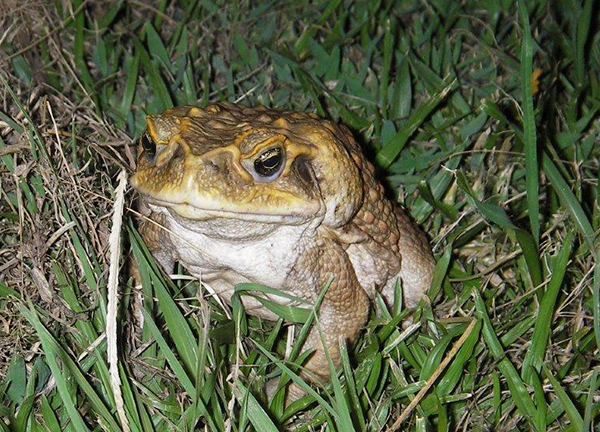Cane toads
How to identify a cane toad
Eggs
Cane toad eggs are laid in long chains with individual eggs which look like black beads encased in jelly. Often eggs are placed in double rows along the strand.
Several females will generally lay eggs in the same water and each female lays up to 35,000 eggs.
Strands of eggs often become tangled and look like a mass of eggs.
If you pick up the eggs with a rake or a stick, the individual strands will hang down.
Tadpoles
Cane toad tadpoles are shiny black on top and have a plain dark bluish grey or black belly.
The body is an oval shape, pointed at the snout and often broad across the gills.
The fins are totally transparent.
The tail is short, thin and rounded at the tip. It is usually 1.25 to 1.5 times the length of the body.
Tadpoles are small and only grow to 30mm in length, with the body about 11mm long at most.
Toad tadpoles tend to form large, slow-moving groups.
They do not come up to the surface to breathe like the tadpoles of native frogs.
Juveniles
Juvenile cane toads are quite different to adults, with smoother, darker skin, darker blotches and bars and a lack of obvious parotoid glands on their backs.
Any toads under 4cm may look similar to a native frog.
You can tell them apart by their upright stance.
They also cluster near water and are active during the day.
Adults
Adult cane toads are large, generally 9cm to 15cm long, but can grow up to 24cm.
They are heavily built and the skin on top is rough, dry and covered in warts. The colour can vary from grey, olive, yellow-brown to red-brown.
Their underparts are lighter and usually a mottled brown.
Their heads are bony with a pointed snout and there is a distinctive ridge over their eyes that meets above their nose.
Behind and just below each eye is a distinctive circular ear drum.
On top of each shoulder is a large sack - this is the toxin-producing parotoid gland.
Cane toads have slightly webbed, leathery hind feet, while the front feet have no webbing and are relatively small in size.
They have an upright stance and walk or move small distances in short, rapid hops, unlike most native species, which leap.
Male toads have a distinctive call, a high-pitched broken brrrr sound that has sounds similar to a motor running, a telephone dial tone or a long loud purring trill.
Cane toads prefer places that are well lit and often group in open areas to find food.
They are unable to jump high and are poor climbers. They also need daily access to water.
More information
For more on cane toad identification, get the poster PDF (317.3 KB).
Print all pages in this section
Give feedback about this page.
Share this page:
URL copied!
